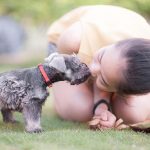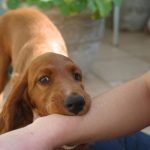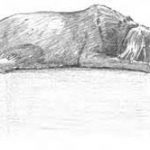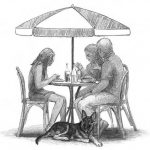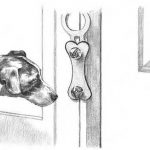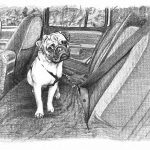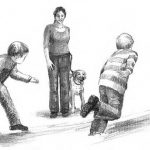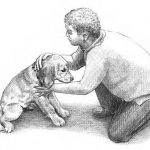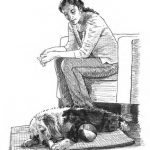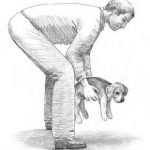Dealing with Daily Hassles
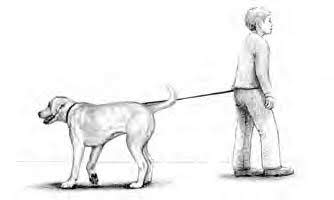
In This Chapter
- Finding out how to handle a chewer
- Controlling your pup’s nipping and mouthing
- Dealing with a pup who jumps
- Discovering the best way to train your pup
No one likes having chewed carpets, scratched doors, or company that hides from a jumping puppy when you open the door. The first step in resolving these kinds of actions is to understand that you and your puppy aren’t sharing the same worldview. For example, when your puppy jumps on company, he enjoys every minute of the chaos that follows when you try to keep him down. And while you don’t appreciate it, a chewed carpet is usually a sign of boredom, anxiety, or teething. To resolve the behaviors that you don’t like, you have to look at them from your puppy’s perspective, and then you have to modify your behavior to change his reactions.
Three Ingredients of a Good Correction
– It should be seen as coming from the environment, not from you.
– It should cause an immediate withdrawal of group interaction.
– It should consist of a verbal or physical redirection to a more appropriate displacement activity that’s rewarded with your reconnection.
Remember
If attention (negative or positive) reinforces behavior, you can see why a behavior that causes group withdrawal can be easily extinguished. An environmental reaction may include an unsettling tug of a leash, a spritz from a spray bottle, or a sharp noise, such as a shake of a can of pennies or a loud horn. Specific interruptions are outlined in each section, but always remember to direct your puppy to an alternative behavior that reestablishes your connection.
Stopping the Chewing Frenzy
Get Bitter Apple — and lots of it
Tip
Believe it or not, some puppies like the taste of Bitter Apple. If your pup is a founding member of this club, try some red-pepper juice with a little garlic or Tabasco sauce. Or you can try the new product called Bitter Bitters, which can be purchased only through your veterinarian.
Offer one main toy plus a surplus of surprises
– Keep your supply of play toys in a special place (designating a box or drawer), bringing them out for special interaction times.
– Designate one toy that’s only offered during greetings. I use a hollow bone stuffed with peanut butter.
Be aware of prize envy
Remember
If you yell at your puppy after he’s begun to grab an object he shouldn’t or after he’s finished chewing, you only damage your relationship with him. Yelling afterwards communicates prize envy — what’s being grabbed is valuable because of the challenge to get it back. If you give the correction too late, your puppy thinks “Wow, what a great prize — everybody wants to take it from me!”
Correct the thought process
Warning!
Correcting a puppy younger than 12 weeks is tantamount to child abuse. Sure, he may look like he knows better than to chew your grandmother’s heirloom hanky, but I’ve got news for you: He’s only terrified. Put the situation in perspective: Imagine a giant monster chasing you down shouting unintelligible epithets. That wouldn’t be too pleasant, would it?
Tip
Set up a situation with something your puppy’s obsessed with — tissues, shoes, a Barbie doll, or whatever else strikes his fancy — and follow these steps:
1. While your puppy’s resting in another room, set the object in the middle of the floor.
2. Bring your puppy to the object on his leash.
3. The second your puppy notices the object, say “Nope” and tug back on the leash.
4. Pick up the object and shout at it — without looking at your puppy (see Figure 16-1).
You read right: Get angry at the object, not at your puppy. You’re doing the puppy version of telling a child the stove is hot — the focus isn’t on the child’s being bad but on the fact that the object is unsafe for her.
Remember
Don’t even look at your puppy as you mouth off to the naughty thing. Your neighbors may commit you, but your puppy will love you for it.
5. Walk by the object again.
Your puppy should avoid it like the plague (see Figure 16-2). If he doesn’t, consider his age — he may be too impulsive to absorb this lesson (wait a month and repeat this sequence) or you may be looking at him, or perhaps your timing is off. Say “No” as your puppy approaches the item, and then scold it (not your puppy) sternly!
Warning!
Don’t practice this exercise off-lead. If you can’t stabilize him, he’s likely to dance about and dart away from you, turning this lesson into a game of cat and mouse.
Use treat cups when your pup’s caught in the act
Tip
First you need to communicate to your puppy that your approach with the treat cup is a good thing. Therefore, anytime your puppy is chewing on an acceptable object, go over to your pup while shaking the treat cup, say “Give,” offer him a treat, and leave. When your puppy’s eating a meal, shake the cup, say “Give,” offer him a treat, and leave.
Tip
Consider all objects your puppy grabs, good or bad, as treasures, and he’ll be much more cooperative. Be mindful to be most engaging when your puppy is playing with his toy. As he matures, he’ll be less focused on “things” and most engaged in what brings you mutual satisfaction.
Calmly kiss your puppy-destroyed things goodbye
Remember
Your puppy’s mouth is equivalent to your hands; if your puppy is nervous or fidgety, he chews. I’m sure if your puppy could surf the Net, scan the soaps, or twiddle his thumbs, he would, but because he can’t, chewing has to do.
Controlling Mouthing and Nipping
Warning!
Puppies interpret discipline as confrontational play. Excessive physical corrections result in aggression, so be wise and stay cool.
Remember
What your puppy wants to know is who’s a puppy and who’s not. The answer determines the type of mouthing or nipping he uses: soft or playful. Usually, everyone gets categorized as a puppy. Why? Well, for starters, most people pull their hands away when nipped. To a human, drawing back is self-defense; to a pup, however, it’s an invitation to play. Even if you were to correct your young puppy, he wouldn’t understand (it’s like correcting a 1-year-old baby for pulling your hair). So what should you do? Good question. Your approach depends on your puppy’s age. Check out the following sections to find how to correct your pup.
Correcting pups younger than 16 weeks
Remember
Physical corrections get interpreted as confrontational play, so it’s at this point that a puppy’s mouthing can escalate to nipping as a defensive reaction to your corrections.
– If your puppy doesn’t need anything and he still won’t quit, crate or isolate him with a favorite bone. Don’t scold your puppy as you isolate him. Calmly place the puppy in his area.
– Whenever your puppy licks you, say “Kisses” and praise him warmly. Encourage licking by slathering your hands with a frozen stick of butter. Yum! With the butter treat, he’ll gladly lick your hand instead of mouthing it.
– Withhold your attention when your puppy nips softly. Keep your hand still, because withdrawing your hand is an invitation to play and nip harder.
– If your puppy starts biting down hard, turn quickly, say “Ep, ep!” and glare into his eyes for two seconds. By the mere fact that you don’t look at him often, this intense glare will surprise him. Just as quickly, go back to your normal routine. If he knows the direction “Kisses,” encourage this to enable a reconnection.
If he persists, try spritzing yourself with Bitter Apple or putting a leash on your puppy so you can tug the lead sharply to the side when he nips hard. If necessary, place him in a quiet area to cool off.
Correcting pups over 16 weeks
Warning!
– Stop all challenge games. These games include wrestling, tug of war, chasing your puppy around, and teasing. When you engage in these types of activities, you’re sending the wrong message. These games teach puppies to challenge you and to clamp down hard on any object — a leash, the laundry, your shirt, or even your skin. For game alternatives, see Chapter Ten Fun Games.
– Discourage all nipping, whether it’s a bite on your arm or a nibble on your finger. Teeth don’t belong on human skin, period.
– Put the leading applications in Chapters Teaching Everyday Etiquette and Training through Your Pup’s Growth Stages into action. It’s time for you to start structuring your interaction.
– Purchase a few weapons to use in defense, such as Binaca mouth spray, Bitter Apple spray, and a blaster or long-distance squirt gun.
Remember
Never stare at your pup while you spritz or spray him. Doing so turns an unpleasant result into a confrontational interaction.
– Leave a leash on your puppy so you have something to direct him with and so you can avoid physical confrontation. If your puppy’s not wearing a leash, place a short drag lead onto his buckle collar.
– If your puppy begins to mouth, turn to him and use a lead or collar to tug his head from your body, or spritz the region he’s nipping with a mouth spray. Don’t glare at your puppy as you correct him — he’ll perceive your actions as confrontational play.
– If he continues to nip, ask yourself these questions: Do I look convincing? Am I tugging or pulling? (Pulling encourages play.) Is my puppy taking me seriously? You may need more training before you earn his respect. Please reference Chapters Teaching Everyday Etiquette and Training through Your Pup’s Growth Stages for good exercises to start you off.
Handling grabbing and chasing
The bathrobe assault
Warning!
If this problem persists, get help now. It can develop into postpuberty aggression. No joke.
The child chaser
1. Put your pup on his leash and ask the kids to race around in front of you.
2. Anytime your puppy looks tempted to lunge, tug back and say “Shhh.”
3. Repeat as often as necessary to gain control.
Grounding the Joyous Jumper
Remember
Puppies who jump need to learn the four paw rule, which means that they receive no attention until all four paws are on the floor. That said, everybody in your household needs to respect this rule, too — friends and visitors alike. For your puppy to understand that the four paw rule applies everywhere and with everyone, consistency is a must! Soon you’ll realize that your puppy isn’t the most difficult one to train!
You’re home! You’re home!
– Come home and ignore your puppy until he’s given up the jumping vigil.
– Keep a basket of balls or squeaky toys by the door. When you come in, toss one on the ground to refocus your puppy’s energy.
– If your puppy’s crated, don’t let him out immediately; wait until he’s calm.
Tip
If you have kids, when the puppy jumps up, tell them to “close up shop,” and you do the same. Cross your arms in front of your chest and look to the sky (see Figure 16-3). Don’t look down until the coast is clear. Remember that consistency is key. If one family member follows the program but the others encourage jumping, your puppy will jump-test all visitors.
Remember
Puppies mimic their leaders’ energy levels. If you come home to an excited puppy and you, too, get excited, you’re sending the message that his excitement is acceptable. Instead, come in calm and wait until he’s settled down to greet your puppy.
We have company!
– Practice doorbell setups.
– Do the reverse yo-yo.
– Create a greeting station.
– Designate a greeting toy.
Attention, please!
Tip
If your puppy’s a real nudger, keep a lead (short or long) attached to his collar. When he jumps, grasp the lead and tug your puppy sideways quickly (this move is called a fly flick) as you continue to ignore him (give no eye contact, body language, or verbal corrections).
I wanna see what’s on the counter, too!
Remember
The reason your puppy grabs when your back is turned or you leave the room is so he can avoid a challenge: Your puppy sees your eyes and mouth (hands equal mouths in the puppy world) interacting with objects on the countertops all day. When he copies you, you bark (shouting is the same as barking to a puppy) and challenge him for whatever the prize is. Do you see the canine message? “Whatever is on the counter must be great, so I better grab it when all backs are turned or I’ll have to give it up.” Follow these steps to solve this problem with dignity:
1. Place something tempting on the counter and bring your puppy into the room on leash.
2. The instant your puppy looks up to sniff the counter, tug the lead back, say “Nope,” and shout at the counter “Bad counter!”
3. Continue to work in the kitchen, catching your puppy the moment he so much as looks longingly at the countertop. When you do catch him, repeat Step 2.
Tip
If mealtimes are too distracting for your puppy, station him while you cook (see Chapter Teaching Everyday Etiquette for advice on stationing).
That couch sure does look comfy
Warning!
Most people invite puppies on the furniture only to regret it later. If you have a puppy and you don’t want him on your furniture permanently, do yourself a favor and discourage the behavior from the start.
Level training for young pups
1. Place your puppy on a leash and walk up to your couch or bed.
2. The second he prepares for the jump, tug back and say “Nope!”
3. Encourage him to sit and, when he does, pet him.
4. Walk back and forth until he sits automatically.
1. Lead your puppy to the couch or bed and sit down yourself.
2. If he goes to jump, tug sideways and ignore him until he sits quietly.
3. Reward his cooperation with a chew toy.
Remember
Young puppies should be level trained because their seeing you above them, whether on a couch or bed, communicates your authority passively. As your puppy matures, you can permission train him as detailed later in this section.
Tip
Be fair — set up a play station nearby to help your puppy feel welcome and directed when you’re relaxing on the furniture. (See Chapter Teaching Everyday Etiquette for tips on setting up play stations.)
Permission training for older puppies
Warning!
Wait until your puppy is at least 6 months old to introduce the concept of “permission.” Until this point, you should level train to ensure that he respects your authority and doesn’t see you as a puppy.
1. No furniture for one week.
This is an important step if you want to earn your puppy’s respect and focus. For this step, follow the steps outlined in the level training section.
2. Bring your puppy to the furniture and ask him to “Sit” and “Wait.”
Sitting and looking to you is how your puppy should learn to ask permission to join you (see Figure 16-4).
3. Next, tap the cushion and instruct “Up.”
He’ll freeze and look confused.
4. Guide him up gently, and pet him lovingly.
5. After 5 to 10 minutes, lead him off the couch and say “Off.”
Remember
If your puppy gets hyper on the furniture, he’s too young to contain the excitement of being on your level. Wait a couple months before reintroducing permission training.
1 Remedying Leash Resistance
2 The lunge and drag
1. Hold a 6-foot leash in your hand or tie it around your waist.
2. Walk in a straight line (see Figure 16-5a). If your puppy races out, call his name and quickly turn about and walk in the opposite direction (see Figure 16-5b).
In the likelihood that he doesn’t follow, he’ll get a quick unpleasant tug, reminding him to pay more attention the next time!
3. Repeat these turnabouts until your dog is predictably focusing on you.
4. Now break out into a circle, holding the leash behind your bottom to push the leash back with the trunk of your body if your puppy starts his pulling.
Mule wannabes
– Drag him along (for obvious reasons)
– Turn to face him, run back, or lift him up
Remember
Acknowledging your puppy’s resistance with coddling will create a dog who is plagued by learned helplessness. Coddling won’t teach him how to follow along. You have a few options to stop your pup’s resistance. Follow these guidelines:
– Let your puppy drag his leash about inside. Review the leash training techniques in Chapter Teaching Everyday Etiquette, practicing them again if necessary.
– Lure him along with a favorite treat or toy. Gradually extend the distance between each reinforcement.
– Condition your puppy to the sound of a treat cup and/or a clicker. Use these combinations to encourage and reinforce your puppy forward.
– If he resists you, instead of turning to urge him forward, simply kneel in front of him (still facing forward) and tap the ground with your finger while you shake the treat cup or clap your hands to urge him along.
Refocusing a Runner
Remember
If your dog is clearly running away from you, your reaction to his behavior may be making matters worse. Yelling at him either when he’s running or after you’re reunited won’t warm him to your calling. In fact, your stringency may be rather off-putting. Being with your puppy is like playing on a team: You’re his captain. Wouldn’t you want to have a captain who was positive and upbeat even when you made a mistake? Give your puppy this same respect.
Methinks I Need Some Help!
Remember
Free advice never pays. If you try a little of this and a little of that, guess who’s going to suffer? That’s right — your puppy. You’ll make the poor guy crazy.
Tip
Professional trainers for your pupA couple associations certify and list trainers in different parts of the country. The APDT (Association of Pet Dog Trainers) certifies and welcomes professional dog trainers and educators who are committed to their profession and who seek like-minded people to meet and exchange ideas with; it holds yearly conferences to promote ideas, educate, and reinforce the ideals of the dog-training profession. The APDT promotes dog-friendly training techniques and serves to educate the public, as well the veterinary professionals, about the benefits of a positive training approach. Here’s how to contact the group:
The IACP (International Association of Canine Professionals) welcomes all professionals associated with dogs, including trainers, groomers, kennel owners, pet sitters, merchants, and veterinarians. They list members, and although they mindfully attest to high standards, a membership fee can buy association. It’s still up to you to determine whether an individual is up to your standards. Of course, membership in a respectable association is a good sign. You can reach the IACP here:
|
Finding the right puppy trainer
A personal trainer
– Put yourself in your client’s shoes.
– Know that the client is trying to do the right thing.
– Understand the puppy’s personality and listen to what the puppy is trying to communicate with his behavior.
– Know when you can’t help. Be honest with your client.
– Help your client understand why the puppy is behaving inappropriately. Help the client think for her puppy.
– Teach the client to think like a puppy, enabling mutual communication. (Turn to Chapter Socialization and Civility for info on speaking Doglish.)
– Help the client structure her home.
– Teach the client patience, tolerance, understanding, and sympathy. After all, she obviously loves her puppy.
Remember
Not all trainers are in this profession because they love puppies first and foremost. Some of them are in it for the money — I suggest you beware of those types. Other trainers are wonderful with puppies but don’t excel in human communication skills. Look for someone who can train you as well as your puppy.
A group trainer
Tip
Here are some questions you can ask:
– How many puppies are in the class? Are the classes divided by age or class levels? The class size should be limited (I limit mine to six) and must be divided by age and experience. I offer Puppy Kindergarten classes for puppies who are less than 6 months old, Grade School for inexperienced pupils, and High School and College for advanced students.
– Do you have a favorite breed of puppy, or do you have experience with a wide variety of breeds? The answer can indicate a strong bias on the part of the instructor. Make sure your instructor isn’t breed-biased. Your puppy should be seen as a unique and special personality, not a stereotype. Your instructor should be versed in breed-specific tendencies, however, and help you understand your puppy’s individual character.
– What do you teach in class? Basic commands are necessary: Heel, Sit-Stay, Come, and Down. Find out whether the instructor spends time explaining how to integrate these directions in your life.
Which is better — private or group training?People often ask me what the best way to train is: group or private lessons. Honestly, it depends on your individual situation, but often the best approach is to combine the two. Private lessons give you one-on-one attention and a complete focus on your frustrations and goals. A well-run class, however, exposes your puppy to a social atmosphere while at the same time organizing lessons that can be repeated at home. |
– Are the classes inside or outside? Having access to both environments is best.
– Are behavior problems discussed? Bad behavior is often what encourages many people to train their puppies. The instructor should be as comfortable talking about problem behavior as he or she is with command training.
– Do you have a make-up policy? If not, can you speak to the instructor to find out what you’ve missed?
– Is family participation encouraged? Can the kids come? The instructor should help you understand how your puppy relates to your entire family and should encourage everyone to participate in the training.









